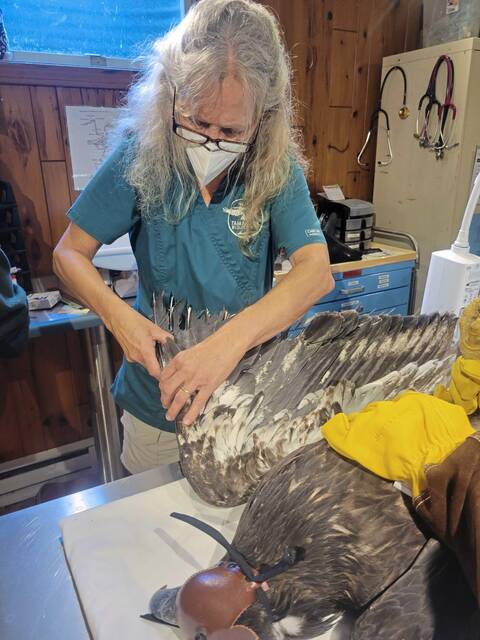Injured steel mill bald eagle 'imped' with grafted feathers
U.S. Steel Irvin Works Manager Don German had never heard of “imping,” let alone the concept of grafting flight feathers from another bird to an injured bald eagle.
German and a Pennsylvania Game Commission warden found and rescued a juvenile bald eagle in June that couldn’t fly after it was knocked off a branch by its sibling near their nest on mill property in West Mifflin.
“What the heck is ‘imping,” German said. “I had no clue.”
German would go on to see his rescued eagle fly because of the special procedure. The steelworkers at the plant, following the bird’s plight, named the injured bird Rosie in honor of the World War II icon Rosie the Riveter.
The injured bird was taken to Humane Animal Rescue of Pittsburgh in Verona for examination and initial treatment. The vets found the eagle broke a substantial number of flight and tail feathers when it fell. They transferred it to Tamarack Wildlife Center in Crawford County, which specializes in the care of injured raptors.
Falconers have used the imping technique for years to replace bird feathers, especially essential flight feathers, said Carol Holmgren, Tamarack’s executive director and a licensed wildlife rehabilitator.
While birds molt their feathers every year, it was best to get Rosie flying and in the wild as soon as possible to increase her odds of survival.
Rosie lost nine of its 10 primary flight feathers on one of her wings, some secondary flight feathers and all of her tail feathers. No wonder she couldn’t fly.
Holmgren imps feathers for about six to 10 birds a year, usually replacing a couple of feathers.
“What is unusual is to replace an entire wing of feathers,” she said, although she had done it several times before.
Just before Rosie arrived, an immature bald eagle was admitted for lead poisoning and died.
A little over a third of injured or sick bald eagles admitted to the center suffer from severe lead poisoning, contracted through eating animal carcasses with lead bullets.
A bald eagle found along the Kiski River that died of lead poisoning in 2017 helped prompt the Pennsylvania Game Commission to ask hunters to voluntarily use lead-free bullets or cover the remains of animals shot by lead bullets, particularly groundhogs. Tamarack collaborated with PGC on the lead bullet campaign.
Because eagles are federally protected, Tamarack had to secure permission from the U.S. Fish and Wildlife Service and the state Game Commission for permission to use the dead bird’s feathers.
Usually, Tamarack sends molted feathers and dead eagles to the National Eagle Repository for distribution to Native Americans for religious purposes.
The feathers matched Rosie’s wing perfectly, Holmgren said. The dead eagle was about the same age as Rosie and a female.
Holmgren imped Rosie about a month ago.
“It’s a very precise process,” she said. “Each primary feather is numbered and you have to make sure the new feathers are the correct length.”
The procedure took only a half hour. Holmgren inserted the feathers with a small wooden brace into the shaft and used five-minute epoxy glue to set it.
Volunteers watched the imping, which went smoothly.
“We were just beside ourselves with joy at the gift she was receiving — the gift of a wing to fly.”
Rosie was hooded and calm throughout. When they returned to her aviary, they raised the eagle’s perch from 3 feet to 6 feet.
“She took one flap, a second flap and flew up beautifully to the 6-foot perch,” Holmgren said. “By the next day, she was reaching perches that were 20 feet high and flying the length of the 100-foot aviary.”
Since eagles replace all their flight feathers annually, Rosie’s grafted feathers will grow out as new ones grow in. Some of her damaged tail feathers have grown back.
Holmgren still has to imp several more feathers.
“Now she is doing absolutely fantastic recognizing her food sources, gaining flight skills and accuracy as well as increasing social skills,” Holmgren said. Rosie now shares her aviary with another recovering bald eagle.
Rosie could be released back into the wild as early as November.
To thank both rehab centers, U.S. Steel made a $30,000 donation to Humane Animal Rescue and a $20,000 donation to Tamarack.
“We saved an eagle,” German said. “We were blessed to have Carol and her wonderful team, and Katie Kefalos from Humane Animal Rescue. Our donation is a small token of our appreciation for what they do.”
Holmgren was grateful for the donation because the nonprofit exists on donations, not government funding.
“Just like human health care workers, it takes an emotional toll on our team when our patients do not survive,” she said. “It can be a comfort when a bird that passes can share the gift of flight with another patient.”
To view the U.S. eagle nest live visit Pixcams online. To learn more about Tamarack Wildlife Center, visit their Facebook page.
Remove the ads from your TribLIVE reading experience but still support the journalists who create the content with TribLIVE Ad-Free.


